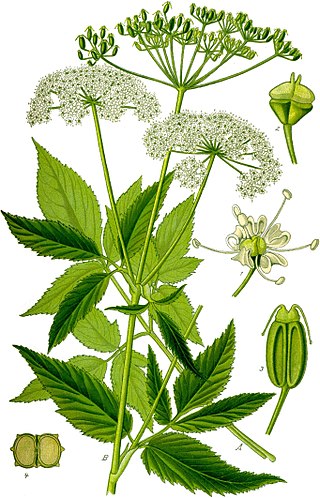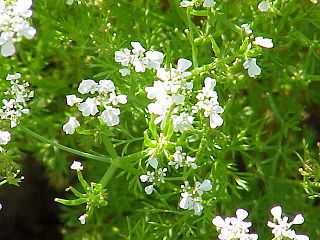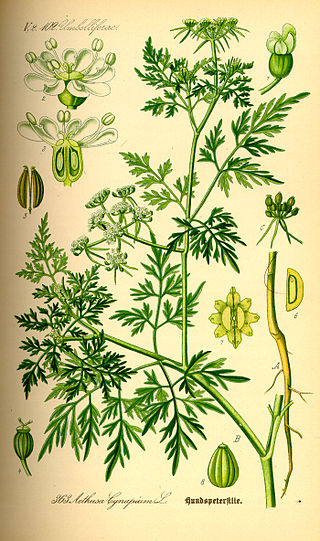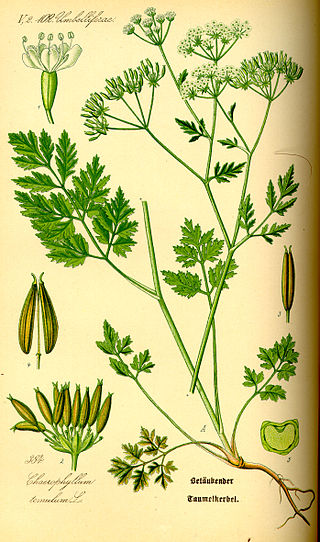
Apiaceae or Umbelliferae is a family of mostly aromatic flowering plants named after the type genus Apium and commonly known as the celery, carrot or parsley family, or simply as umbellifers. It is the 16th-largest family of flowering plants, with more than 3,800 species in about 446 genera, including such well-known and economically important plants as ajwain, angelica, anise, asafoetida, caraway, carrot, celery, chervil, coriander, cumin, dill, fennel, lovage, cow parsley, parsley, parsnip and sea holly, as well as silphium, a plant whose exact identity is unclear and which may be extinct.

Chervil, sometimes called French parsley or garden chervil, is a delicate annual herb related to parsley. It was formerly called myrhis due to its volatile oil with an aroma similar to the resinous substance myrrh. It is commonly used to season mild-flavoured dishes and is a constituent of the French herb mixture fines herbes.

Daucus carota, whose common names include wild carrot, European wild carrot, bird's nest, bishop's lace, and Queen Anne's lace, is a flowering plant in the family Apiaceae. It is native to temperate regions of the Old World and was naturalized in the New World.

Oenanthe, known as water dropworts, oenanthes, water parsleys, and water celeries, are a genus of plants in the family Apiaceae. Most of the species grow in damp ground, such as in marshes or in water.

Aegopodium podagraria, commonly called ground elder, is a species of flowering plant in the carrot family Apiaceae that grows in shady places. The name "ground elder" comes from the superficial similarity of its leaves and flowers to those of elder (Sambucus), which is not closely related. Other common names include herb gerard, bishop's weed, goutweed, gout wort, snow-in-the-mountain, English masterwort and wild masterwort. It is the type species of the genus Aegopodium. It is native to Europe and Asia, but has been introduced around the world as an ornamental plant, where it occasionally poses an ecological threat as an invasive exotic plant.

Heracleum mantegazzianum, commonly known as giant hogweed, is a monocarpic perennial herbaceous plant in the carrot family Apiaceae. H. mantegazzianum is also known as cartwheel-flower, giant cow parsley, giant cow parsnip, or hogsbane. In New Zealand, it is also sometimes called wild parsnip or wild rhubarb.

Anthriscus (chervils) is a common plant genus of the family Apiaceae, growing in Europe and temperate parts of Asia. It comprises 15 species. The genus grows in meadows and verges on slightly wet porous soils. One species, Anthriscus cerefolium is cultivated and used in the kitchen to flavor foods.

Myrrhis odorata, with common names cicely, sweet cicely, myrrh, garden myrrh, and sweet chervil, is a herbaceous perennial plant belonging to the celery family Apiaceae. It is the only species in the genus Myrrhis.

Aethusa cynapium is an annual herb in the flowering plant family Apiaceae, native to Europe, western Asia, and northwest Africa. It is the only member of the genus Aethusa. It is related to hemlock and water-dropwort, and like them it is poisonous, though less so than hemlock. It has been introduced into many other parts of the world and is a common weed in cultivated ground.

Smyrnium olusatrum, common name alexanders is an edible flowering plant of the family Apiaceae (Umbelliferae), which grows on waste ground and in hedges around the Mediterranean and Atlantic coastal regions of Europe. It was formerly widely grown as a pot herb, but is now appreciated mostly by foragers.

Scandix pecten-veneris is a species of edible plant belonging to the family Apiaceae. It is native to Eurasia, but is known to occur elsewhere. It is named for its long fruit, which has a thickened body up to 1.5 centimeters long and a beak which can measure up to 7 centimeters long and is lined with comblike bristles.

Chaerophyllum temulum, the rough chervil, is a species of flowering plant in the family Apiaceae.

Selinum carvifolia is a flowering plant of the genus Selinum in the family Apiaceae. The specific name carvifolia signifies 'having leaves resembling those of Caraway'. It is a plant of fens and damp meadows, growing in most of Europe, with the exception of much of the Mediterranean region, eastwards to Central Asia. Its common name in English is Cambridge milk parsley, because it is confined, in the UK, to the county of Cambridgeshire and closely resembles milk parsley, an umbellifer of another genus, but found in similar habitats. The two plants are not only similar in appearance, but also grow in similar moist habitats, although they may be told apart in the following manner: P. palustre has hollow, often purplish stems, pinnatifid leaf lobes and deflexed bracteoles; while S. carvifolia has solid, greenish stems, entire or sometimes lobed leaf-lobes and erecto-patent bracteoles. Also, when the two plants are in fruit, another difference becomes apparent: the three dorsal ridges on the fruit of S. carvifolia are winged, while those on the fruit of P. palustre are not. Yet a further difference lies in the respective leaflets of the plants : those of Peucedanum palustre are blunt and pale at the tip, while those of Selinum carvifolia are sharply pointed and of a darker green. S. carvifolia used also to occur in the English counties of Nottinghamshire and Lincolnshire but is now extinct in both. Growing in only three small Cambridgeshire fens, it is one of England's rarest umbellifers. It is naturalized in the United States, where it is known by the common name little-leaf angelica.

Conium maculatum, colloquially known as hemlock, poison hemlock or wild hemlock, is a highly poisonous flowering plant in the carrot family Apiaceae, native to Europe and North Africa. It is herbaceous without woody parts and has a biennial lifecycle. A hardy plant capable of living in a variety of environments, hemlock is widely naturalised in locations outside its native range, such as parts of Australia, West Asia, and North and South America, to which it has been introduced. It is capable of spreading and thereby becoming an invasive weed.

Oenanthe pimpinelloides is a species of flowering plant in the family Apiaceae known by the common name corky-fruited water-dropwort. It is a plant of damp or dry grassland and more ruderal tall herb communities.
A. sylvestris may refer to:

Epermenia chaerophyllella, also known as the garden lance-wing, is a moth of the family Epermeniidae first described by Johann August Ephraim Goeze in 1783. It is found in all of Europe and Asia Minor.
Parsley or garden parsley most often refers to the widely cultivated culinary herb Petroselinum crispum

Oenanthe lachenalii, parsley water-dropwort, is a flowering plant in the carrot family, which is native to Europe and parts of North Africa. It is a declining plant of coastal wetlands.




















